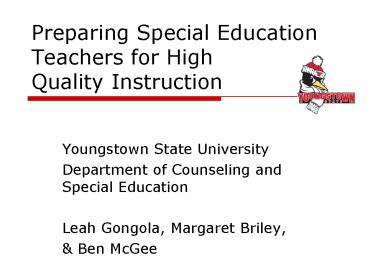Preparing Special Education Teachers for High Quality Instruction PowerPoint PPT Presentation
1 / 17
Title: Preparing Special Education Teachers for High Quality Instruction
1
Preparing Special Education Teachers for High
Quality Instruction
- Youngstown State University
- Department of Counseling and Special Education
- Leah Gongola, Margaret Briley,
- Ben McGee
2
Current Program Description
- 4 year undergraduate program
- Initial licensure
- K-12
- Mild to Moderate OR
- Moderate to Intensive
- Will graduate highly qualified in Language Arts
- Upon passing Praxis II Reading
3
Focus Groups
- School superintendents (7 total)
- Secondary school administrators (6)
- Secondary school teachers (8)
- Elementary school administrators (6)
4
Focus Group Responses
- Majority in favor of cross-categorical
- Question 1 responses
- Graduates should be well prepared to teach all
students with disabilities - Cross-categorical units in schools, so it makes
sense to align the licensure as so - Cross-categorical would make scheduling less
complicated
5
Focus Group Responses
- Majority in favor of HQT in 2 areas
- Question 2 responses
- Reservations about extending undergraduate
program to become HQT in 2 areas - Should not compromise graduating effective
teachers in the effort for candidates to become
HQT in 2 areas
6
Survey Questions and Results
- What should an undergraduate SPED program be
designed as? - 25 Mild to moderate only
- 50 Cross categorical
- In order of importance, list the greatest needs
for HQT content areas - 62.5 Language Arts
- 75 Math
- 87.5 Science
7
Proposed Grade Bands
- K-12
- Mild to Intensive
- Cross-categorical
- In response to survey results completed by Region
V stakeholders (e.g., local superintendents,
special education directors)
8
Planned Re-designed Program
- 4 year undergraduate program
- Probable addition of summer coursework
- Minimally lengthens SPED program
- HQT coursework in Language Arts and 1 additional
content area - Choice of Math, Social Studies, or Science
- Working with content area specialists to
determine and sequence of content area courses - Shaping coursework to enable candidates to pass
Praxis at the middle school level
9
Math Content Area
- Met with four professors from mathematics
department - Jointly agreed that SPED students seeking HQT
status in mathematics would be required to take a
minimum of four courses - Two courses in middle school math one
combination course in algebra and geometry one
course in math problem solving
10
Social Studies Content Area
- US History (GER)
- World Civilizations (GER)
- American Government (add 3 s.h.)
- World Geography (add 3 s.h.)
- Ohio History (add 3 s.h.)
11
Content Areas in Development
- Science
- Language Arts at 7-12th grades
12
Changes to Current SPED Program
- Scope and sequence overhaul
- Merging some courses
- Creating other courses (e.g., Social
Communication) - Creating a visual curriculum map.
- Identifying when to take courses, prerequisites,
when to take Praxis tests, of credit hours, and
of fieldwork hours
13
Impact on General Education Programs
- Integrated discussions
- Importance of modeling co-teaching to our
education candidates (challenge) - Current discussions with literacy faculty
regarding necessary reading content - Rationale SPED candidates need tools to educate
students with diverse needs - Target curriculums and systems specific to the
population of students with special needs (e.g.,
Edmark, RtI)
14
Additional Resources Needed
- Time to write individual courses
- Development of course syllabi
- Catalog description, NCATE/CEC standards
- Time to develop course sequence
- Spanning from freshman to senior year
- Time for planning with internal SPED department
and external departments - Math, Science, Social Studies
15
Challenges
- Collaboration with other departments (general
education, math, science, social studies) - Develop cohesive coursework to meet HQT criteria
and Praxis preparation - Condensing all required coursework for
cross-categorical and 2 HQT content areas into a
4 year program - Being conscientious about program rigor
- Heightened emphasis on self-reflection and
personal growth
16
Advantages of Program Re-design
- Will allow students to graduate better prepared
to service students with an array of diverse
needs and across varying ages - K-12
- Mild to Intensive
- More marketable
- Again, in response to stakeholder needs
17
Field Experiences within Proposed Program
- Field Experiences Assigned to Practica
- Mild/Moderate 30 clock hours
- Moderate Intense 30 clock hours
- Severe Behavior 30 clock hours
- Special Teacher Education Program (STEP)
- 9 weeks
- 218 clock hours

